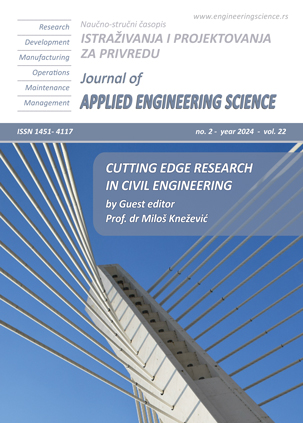NATIONAL SEISMIC RISK ASSESSMENT FOR MONTENEGRO
Abstract
The previous seismic risk assessment for Montenegro was done after the 1979 earthquake for the purpose of developing the Spatial Plan of Montenegro. Following that catastrophic event, a robust response from relevant institutions ensued, focusing on mitigating seismic risk and regulating construction in vulnerable areas. This period witnessed significant strides in projects to revitalize and reconstruct Montenegrin society. As a result of these efforts, a study was developed, representing a valuable document on vulnerability and seismic risk based on the consequences of the 1979 earthquake. Recognizing seismic risk as a dynamic parameter, it is necessary to conduct periodic updates in risk studies. Regrettably, Montenegro's seismic risk assessment remained stagnant until 2021, when extensive research was undertaken as part of a project funded by the European Commission. The Department of Civil Protection (DCP) coordinated the project in which the National Risk Assessment (NRA), focused on nine different natural and technical-technological risks, was developed. The participation of the national DCP ensured the scientific community's involvement, including the researchers from the University of Montenegro, the Faculty of Civil Engineering and the National Seismological Institute. This collaboration, guided and coordinated by the DCP, resulted in the successful completion of a new national seismic risk assessment. The paper briefly presents results and methodology for seismic risk assessment, providing details on available and used data for exposure and vulnerability models. The discussion includes results on damages (residential buildings and road infrastructure), impact on people, economic losses and presentation of political and social impacts for two earthquake scenarios. Finally, the seismic risk level is calculated and presented in risk matrices.
References
Petrovski, J., et al. (1984). Primjenjena metodologija za ocjenu povredljivosti i seizmičkog rizika razvijena na osnovu istraživanja efekata zeljotresa od 15.04.1979. godine u Crnoj Gori. Skoplje: IZIIS.
Ministarstvo unutrašnjih poslova – Direktorat za zaštitu i spašavanje. (2021). Projena rizika od katastrofa Crna Gora. ISBN 978-9940-8815-1-1.
European Commission. (2010). Risk assessment and mapping guidelines for disaster management (SEC (2010) 1626 final). Brussels: European Commission.
SERA. (2017-2020). The Seismology and Earthquake Engineering Research Infrastructure Alliance for Europe. http://www.sera-eu.org/en/about/aboutus/ (from February 2024)
European Seismological Commission. (1998). European Macroseismic Scale 1998. In G. Grünthal (Ed.), Luxembourg: European Seismological Commission. ISBN 2-87977-008-4.
Federal Emergency Management Agency. (2003). HAZUS®MH –MR4 Technical Manual - Multi-hazard loss estimation methodology, Earthquake model. Washington, DC: FEMA.
Borzi, B., Faravelli, M., Onida, M., Polli, D., Quaroni, D., Pagano, M., & Di Meo, A. (2018). Piattaforma Irma (Italian Risk MAps). In GNGTS 2018 Conference. Bologna.
Applied Technology Council. (1991). Seismic vulnerability and impact of disruption of lifelines in the conterminous United States (ATC-25). Washington, D.C.: FEMA.
Institut za zemljotresno inženjerstvo i inženjersku seizmologiju, Univerzitet “Kiril i Metodije” Skoplje, & Republički zavod za urbanizam i projektovanje Titograd. (1984). Studija za ocjenu očekivane povredljivosti i seizmičkog rizika razvijena na osnovu istraživanja efekata zemljotresa od 15. aprila 1979. godine u SR Crnoj Gori (SFR Jugoslavija). Skoplje: IZIIS.

